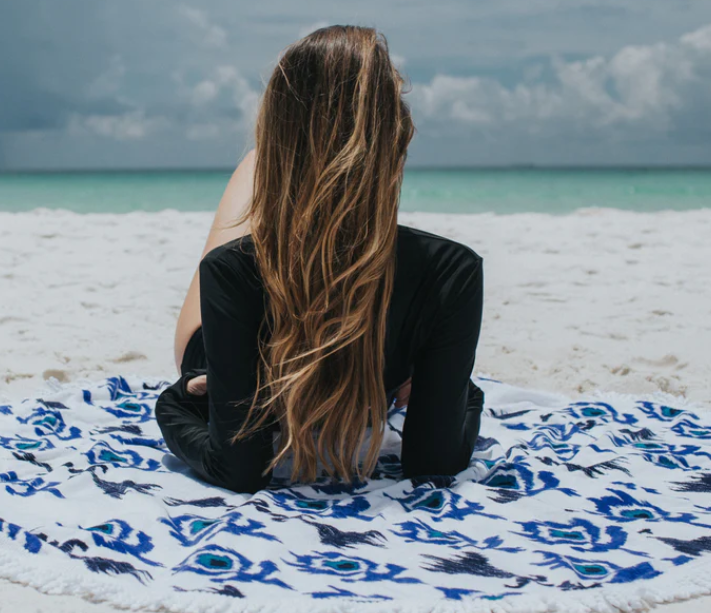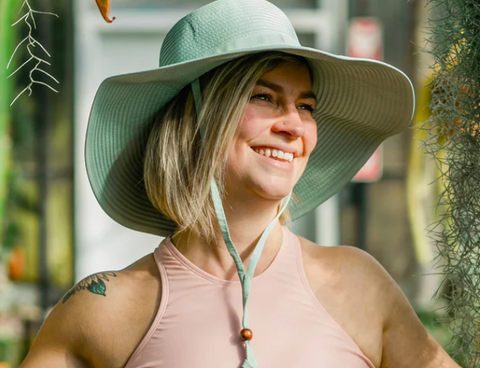
What SPF should I use?
SPF is one of your best defenses against harmful UV radiation. The American Academy of Dermatology recommends selecting a sunscreen with an SPF of 30 or higher to ensure adequate protection.
But what does SPF mean for you? It's not just a number, but a guideline to help you choose the best sunscreen for your needs, considering factors such as skin sensitivity, exposure duration, and environmental conditions.
Quick links:
Important sunscreen ingredients
Why is sun protection important?
Read on to find out what SPF is the best for you!
What is SPF?
SPF, or sun protection factor, is a term that refers to the measure of how effectively a sunscreen or other form of sun protection can protect human skin from the harmful effects of the sun’s ultraviolet (UV) rays.
SPF is a numerical rating that indicates the levels of protection that a product offers against UV radiation. The SPF value of a product specifies the amount of time that you will be protected, as well as how well you will be protected. Higher SPF will provide better protection against ultraviolet radiation over a longer period of time.
UV radiation is divided into three main types of UV rays, based on wavelength:
- UVA: primarily associated with the premature aging of the skin (wrinkles, age spots, etc..). Contribute significantly to the development of skin cancers. The longest wavelength of the three types.
- UVB: responsible for causing sunburns and more immediate, visible skin damage. A significant contributor to the development of skin cancers. Shorter wavelength than UVA rays.
- UVC: least dangerous of the three types of UV rays. Absorbed almost entirely by the Earth’s atmosphere.
How to choose the right SPF
The right SPF for your skin type and environment is key to getting the protection you need. As you evaluate your SPF options, keep the following guidelines in mind:
Consider your skin type
If you have very fair skin that burns easily, opt for a higher SPF between 30 and 50. Those with medium skin tones or tans can likely get by with an SPF of 15 or 30. People with darker complexions still need protection and should use an SPF 15 at minimum.
Factor in your environment
If you live in a high UV index area or spend a lot of time outdoors, choose a higher SPF. Go for an SPF rating of 30 or higher if you'll be outside during peak sun hours. An SPF 15 can suffice if you are only exposed briefly or during lower UV index hours.
Read sunscreen labels for broad-spectrum
Make sure that the label says "broad spectrum" to confirm protection against both UVA and UVB rays. Both contribute to skin damage and an increased risk of skin cancer.
Consider water resistance
If swimming or sweating are in your plans, use a water-resistant SPF that states 40 or 80 minutes of protection. Reapply these after 40 or 80 minutes to ensure you stay protected consistently.
Check expiration dates
SPF effectiveness can decrease over time. Check and follow the expiration date of your sunscreen, and avoid old products. Most sunscreens will maintain their effectiveness for at least 3 years.
Different types of SPF
SPF measures the level of UVB protection sunscreen provides. Higher numbers indicate more protection against UVB rays that cause sunburn. Here are a few standard types of SPF:
- SPF 15 blocks about 93% of UVB rays. It provides decent protection for lower exposure activities. An SPF 15 works well for short periods outside during less intense daylight hours.
- SPF 30 keeps out 97% of UVB rays. It's the minimum recommended SPF for extended outdoor time, especially during peak sunlight hours. SPF 30 is acceptable for longer periods of sun exposure.
- SPF 50 blocks about 98% of UVB rays. While higher than SPF 30, studies show SPF 50 offers only marginally better protection. Because no sunscreen filters 100% of rays, don't think SPF 50 allows you to spend more time in the sun without consequences.
- SPF 100+ filters 99% of UVB rays. Like SPF 50, they provide only slightly more shielding than SPF 30 in reality. There is a cap on how much protection can be provided. These ultra-high SPFs are best for those highly sensitive to the sun.
What are important sunscreen ingredients?
Some key ingredients in sunscreens include:
- Oxybenzone and Avobenzone are two of the most common and effective chemical absorbers. They work by absorbing UV radiation and converting it to small amounts of heat.
- Zinc Oxide and Titanium Dioxide. These mineral or physical sunscreens use fine particles to reflect and scatter UV rays away from the skin. They offer broad protection and are less likely to irritate sensitive skin.
- Octocrylene is a strong chemical absorber often paired with Avobenzone to allow it to last longer. It protects against a wide range of UV wavelengths.
- Octinoxate (Octyl Methoxycinnamate) is one of the most widely used UVB absorbers which protects well against sunburn. It has a thinner texture.
- Homosalate is a chemical absorber that protects against both UVA and UVB rays. It’s fast-acting but the effects don’t last as long as other filters so it is often combined with other protective ingredients.
Ensure your sunscreen contains a mix of absorbers and reflectors for the safest and most balanced protection against UVA and UVB rays. The ingredients list should also say "broad spectrum."
Importance of sun protection
Proper sun protection provides a multitude of health benefits. Here are some of them:
Prevent skin cancer
UV exposure significantly raises the risks of developing melanoma and other skin cancers. You should seek shade, wear protective clothing, and properly apply broad-spectrum SPF 30+ sunscreen that blocks over 95% of the UV radiation that can lead to cancer.
Reduce signs of aging
According to the National Library of Medicine’s research, up to 80% of visible skin aging is caused by the sun's rays. UV radiation breaks down collagen and elastin in the skin, resulting in wrinkles, lines, spots, loose skin, and rough texture. Using sunscreen preserves youthfulness.
Protect from sunburns
Sunburns increase the risk of skin cancer. Using SPF 30 broad spectrum sunscreen shields the skin from sunburns and reduces the potentially damaging effects of UV rays.
Decrease the risk of eye damage
UV rays can contribute to cataracts, macular degeneration, and other forms of eye damage over time. Sunglasses and wide-brimmed hats prevent sun damage to the eyes and the delicate skin around the eyes.
SwimZip’s sun-protective clothing
Here at SwimZip, we’re dedicated to promoting sun-safe fun by developing and delivering sun-protective swimwear that is stylish, functional, and affordable. We have become one of the most trusted UPF 50+ brands that people use to keep themselves and their loved ones safe from the sun.
Supplement sunscreen protection with high-quality sun-protective clothing to get maximum protection and keep your skin safe.
We offer clothing and accessories for every member of the family, including swim trunks for men, swimwear for women, sunsuits for kids, sun hats, rash guards, and more.
We look forward to many more years of making UV protection a zip!
SPF FAQ
What is the best SPF for dark skin?
The best SPF for dark skin is SPF 30. Though higher melanin levels in dark skin offer some sun protection, UV exposure still poses risks. Dermatologists recommend broad spectrum SPF 30 as the minimum to block UVA and UVB rays. Use water-resistant sunscreen with SPF 30 to best protect dark skin.
What are the different types of sunscreen products?
Sunscreens come in two main varieties:
- Mineral sunscreens absorb UV rays and transform them into heat, which is then released from the skin. They often contain ingredients like oxybenzone or avobenzone. They are great for sensitive skin and kids.
- Chemical sunscreens act as a shield, sitting on the skin's surface and reflecting or scattering UV radiation. These typically contain minerals like zinc oxide or titanium dioxide. Some ingredients might irritate sensitive skin.
There are also hybrid sunscreens that combine ingredients of mineral and chemical sunscreens to offer a mix of benefits.
Is SPF 15 enough?
While SPF 15 offers some protection, it's generally considered below the acceptable level for sun exposure. Experts recommend SPF 30 or higher for everyday use, as SPF 15 only blocks about 93% of the UVB rays responsible for sunburns.
Can you still tan with SPF 50?
You can still tan with SPF 50 sunscreen. No sunscreen blocks 100% of UV rays, so even with a high SPF, some UV radiation will reach your skin, potentially causing it to tan. SPF 50 greatly reduces the amount of UV radiation that penetrates the skin, limiting the ability to get a tan, and minimizing the risk of skin damage and skin cancer.
For more on the topic of tanning, see our in-depth article on the best UV index for tanning.
Is SPF 30 or 50 better for fair skin?
For fair skin, SPF 50 provides marginally better protection. It blocks about 1 percent more UVB rays than SPF 30. Proper application techniques matter more than a moderately higher SPF since no sunscreen is 100% protective.
Is SPF 100 good for the skin?
SPF 100 is not necessarily better for the skin than lower SPFs. High SPF sunscreens can create a false sense of security, leading to longer sun exposure without proper reapplication or additional protective measures. While they do offer more protection against UVB rays, the incremental benefits diminish after SPF 50.
What amount of sunscreen should you apply for proper protection?
Most experts recommend applying an ounce of sunscreen to get adequate SPF protection against UVB radiation and ultraviolet light. Spread evenly, and reapply after sun exposure, sweating, or swimming to properly protect the skin.
What active ingredients provide the best skin protection from UV damage?
The most effective sun protection products contain active ingredients such as zinc oxide and titanium dioxide. These physical blockers sit on top of the skin to reflect and scatter ultraviolet light and UVB radiation to prevent it from penetrating skin cells and causing sun damage.
Does spray sunscreen give you enough protection?
While the convenience of spray sunscreens allows quick application to your entire body, they do not always provide an adequate layer of protection. Completely covering dry skin takes several passes, and missing areas leave you vulnerable to sunburns. Combine sprays with lotions to get thorough protection.
Further reading
UPF vs SPF: what is the difference?
Resources
Effect of the sun on visible clinical signs of aging in Caucasian skin. (2013, September 27). NCBI. Retrieved February 19, 2024, from https://www.ncbi.nlm.nih.gov/pmc/articles/PMC3790843/
How to select a sunscreen. (n.d.). American Academy of Dermatology. Retrieved February 19, 2024, from https://www.aad.org/public/everyday-care/sun-protection/shade-clothing-sunscreen/how-to-select-sunscreen




Leave a comment
This site is protected by hCaptcha and the hCaptcha Privacy Policy and Terms of Service apply.